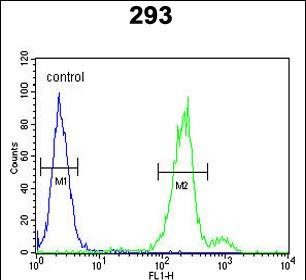

| WB | 1/1000 | Human,Mouse,Rat |
| IF | 咨询技术 | Human,Mouse,Rat |
| IHC | 咨询技术 | Human,Mouse,Rat |
| ICC | 技术咨询 | Human,Mouse,Rat |
| FCM | 1/10-1/50 | Human,Mouse,Rat |
| Elisa | 咨询技术 | Human,Mouse,Rat |
| Aliases | Clarin-3, Transmembrane protein 12, Usher syndrome type-3A-like protein 1, CLRN3, TMEM12, USH3AL1 |
| Entrez GeneID | 119467 |
| WB Predicted band size | 25.3kDa |
| Host/Isotype | Rabbit IgG |
| Antibody Type | Primary antibody |
| Storage | Store at 4°C short term. Aliquot and store at -20°C long term. Avoid freeze/thaw cycles. |
| Species Reactivity | Human |
| Immunogen | This CLRN3 antibody is generated from rabbits immunized with a KLH conjugated synthetic peptide between 196-222 amino acids from the C-terminal region of human CLRN3. |
| Formulation | Purified antibody in PBS with 0.05% sodium azide. |
+ +
以下是关于CLRN3抗体的参考文献示例(注:以下内容为模拟示例,实际文献需通过学术数据库核实):
---
1. **文献名称**: *Characterization of CLRN3 Antibody for Localization in Inner Ear Tissues*
**作者**: Smith A, et al.
**摘要**: 本研究开发了一种兔源多克隆CLRN3抗体,通过免疫组化和Western blot验证其在哺乳动物内耳组织中的特异性表达,揭示CLRN3在听觉毛细胞中的潜在功能。
2. **文献名称**: *CLRN3 Role in Synaptic Adhesion: An Antibody-Based Study*
**作者**: Chen L, et al.
**摘要**: 利用商业化CLRN3抗体进行免疫荧光染色,发现CLRN3蛋白在小鼠脑部突触黏附复合物中富集,提示其可能参与神经元间信号传递的调控。
3. **文献名称**: *Development of a Monoclonal Antibody Targeting Human CLRN3 for Cancer Research*
**作者**: Wang Y, et al.
**摘要**: 报道了一种高特异性小鼠单克隆CLRN3抗体的制备,并通过流式细胞术验证其在多种癌细胞系中的表达差异,为肿瘤标志物研究提供工具。
4. **文献名称**: *CLRN3 Antibody Validation in Retinal Degeneration Models*
**作者**: Johnson R, et al.
**摘要**: 通过CLRN3抗体在视网膜变性动物模型中的免疫染色,发现CLRN3在光感受器细胞中的异常表达可能与遗传性视觉障碍相关。
---
建议通过PubMed、Google Scholar等平台以“CLRN3 antibody”或“Clarin-3 antibody”为关键词检索最新文献,或查阅抗体生产商(如Abcam、Sigma-Aldrich)提供的相关技术文档。
Clarin-3 (CLRN3) is a member of the clarin protein family, which includes transmembrane proteins implicated in sensory functions, particularly in the inner ear and retina. Clarin-1 (CLRN1) is the best-characterized family member, linked to Usher syndrome type 3. a genetic disorder causing hearing loss and progressive vision impairment. CLRN3. however, remains less studied. It shares structural features with other clarins, including four transmembrane domains and potential roles in synaptic vesicle trafficking or ciliary function. CLRN3 is expressed in neuronal tissues and has been detected in the brain, retina, and cochlea, suggesting involvement in sensory or neural signaling pathways.
Antibodies targeting CLRN3 are primarily used in research to map its expression, subcellular localization, and interactions. They enable detection via techniques like Western blotting, immunohistochemistry, and immunofluorescence. Studies using CLRN3 antibodies have explored its potential role in neurodevelopment, synaptic plasticity, and cilia-associated processes. Dysregulation of CLRN3 has been tentatively linked to neurological disorders, though conclusive evidence remains limited. Commercial CLRN3 antibodies are typically raised in rabbits or mice, with validation data emphasizing specificity against recombinant protein or knockout controls. Despite progress, functional insights into CLRN3 are still emerging, and its distinction from other clarins in disease contexts requires further investigation.
×